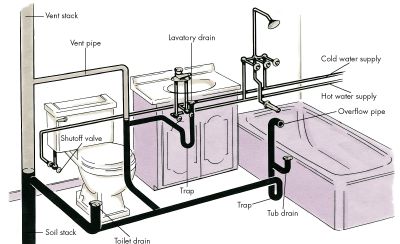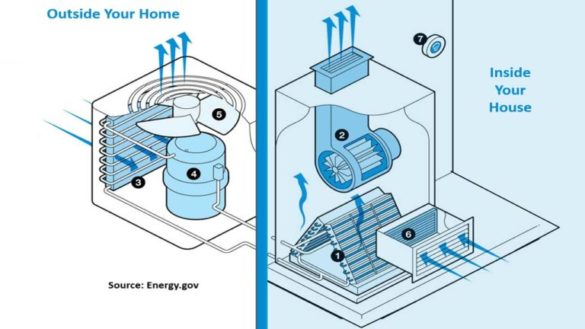Do you find yourself on the lookout for guidance about Exploring Your Homes Plumbing Anatomy?

Recognizing just how your home's pipes system functions is crucial for each property owner. From providing tidy water for drinking, cooking, and showering to securely getting rid of wastewater, a well-maintained pipes system is critical for your family's health and comfort. In this extensive guide, we'll explore the complex network that composes your home's pipes and offer suggestions on upkeep, upgrades, and taking care of usual issues.
Introduction
Your home's plumbing system is more than just a network of pipelines; it's an intricate system that ensures you have accessibility to clean water and efficient wastewater removal. Understanding its elements and how they collaborate can assist you protect against pricey repairs and ensure everything runs smoothly.
Fundamental Parts of a Pipes System
Pipes and Tubing
At the heart of your plumbing system are the pipes and tubing that carry water throughout your home. These can be made of different products such as copper, PVC, or PEX, each with its benefits in regards to longevity and cost-effectiveness.
Components: Sinks, Toilets, Showers, and so on.
Components like sinks, toilets, showers, and bathtubs are where water is used in your house. Comprehending exactly how these components link to the plumbing system assists in identifying issues and preparing upgrades.
Valves and Shut-off Points
Valves manage the flow of water in your pipes system. Shut-off shutoffs are crucial during emergencies or when you require to make fixings, enabling you to separate parts of the system without interrupting water flow to the whole residence.
Water System
Key Water Line
The major water line links your home to the local water supply or a private well. It's where water enters your home and is distributed to various components.
Water Meter and Stress Regulator
The water meter measures your water usage, while a stress regulatory authority makes sure that water streams at a safe pressure throughout your home's pipes system, stopping damage to pipes and components.
Cold Water vs. Hot Water Lines
Understanding the difference between cold water lines, which provide water straight from the main, and hot water lines, which lug warmed water from the water heater, helps in repairing and preparing for upgrades.
Drainage System
Drain Piping and Traps
Drain pipes lug wastewater away from sinks, showers, and toilets to the sewage system or septic tank. Catches stop drain gases from entering your home and also catch debris that could create blockages.
Ventilation Pipelines
Ventilation pipelines allow air right into the drain system, preventing suction that can reduce drain and cause catches to empty. Proper air flow is important for keeping the stability of your plumbing system.
Relevance of Appropriate Drainage
Making sure appropriate drainage protects against backups and water damage. Regularly cleansing drains and keeping traps can protect against costly fixings and prolong the life of your pipes system.
Water Heating Unit
Sorts Of Water Heaters
Hot water heater can be tankless or traditional tank-style. Tankless heating units warm water as needed, while storage tanks save heated water for immediate usage.
How Water Heaters Link to the Pipes System
Comprehending just how water heaters link to both the cold water supply and warm water circulation lines assists in detecting issues like inadequate warm water or leaks.
Maintenance Tips for Water Heaters
On a regular basis purging your hot water heater to remove debris, examining the temperature setups, and evaluating for leakages can extend its life expectancy and boost energy effectiveness.
Usual Pipes Concerns
Leaks and Their Causes
Leakages can happen as a result of aging pipes, loose installations, or high water stress. Dealing with leaks immediately protects against water damages and mold and mildew growth.
Obstructions and Blockages
Blockages in drains pipes and commodes are usually brought on by flushing non-flushable items or an accumulation of oil and hair. Making use of drainpipe displays and bearing in mind what decreases your drains pipes can protect against clogs.
Indicators of Pipes Troubles to Watch For
Low water pressure, sluggish drains pipes, foul odors, or abnormally high water costs are indicators of potential plumbing troubles that need to be addressed immediately.
Plumbing Maintenance Tips
Routine Assessments and Checks
Arrange yearly pipes examinations to capture concerns early. Seek indicators of leakages, deterioration, or mineral build-up in taps and showerheads.
Do It Yourself Upkeep Tasks
Basic jobs like cleaning faucet aerators, checking for commode leakages making use of color tablet computers, or protecting subjected pipes in cold climates can prevent major plumbing problems.
When to Call an Expert Plumbing Technician
Know when a plumbing concern needs professional knowledge. Attempting complex repairs without proper expertise can bring about more damage and higher fixing expenses.
Updating Your Plumbing System
Reasons for Upgrading
Updating to water-efficient components or replacing old pipes can improve water top quality, minimize water expenses, and enhance the value of your home.
Modern Pipes Technologies and Their Advantages
Check out technologies like clever leakage detectors, water-saving toilets, and energy-efficient water heaters that can save cash and decrease environmental influence.
Price Considerations and ROI
Calculate the ahead of time expenses versus long-lasting savings when taking into consideration pipes upgrades. Numerous upgrades pay for themselves via reduced energy bills and less repair work.
Ecological Effect and Conservation
Water-Saving Components and Home Appliances
Installing low-flow taps, showerheads, and bathrooms can considerably lower water use without sacrificing efficiency.
Tips for Decreasing Water Use
Simple behaviors like dealing with leaks promptly, taking shorter showers, and running complete tons of washing and meals can preserve water and lower your utility expenses.
Eco-Friendly Plumbing Options
Think about sustainable pipes products like bamboo for floor covering, which is durable and environmentally friendly, or recycled glass for kitchen counters.
Emergency situation Readiness
Steps to Take Throughout a Plumbing Emergency situation
Know where your shut-off valves lie and how to switch off the water supply in case of a ruptured pipe or major leak.
Value of Having Emergency Situation Get In Touches With Convenient
Keep get in touch with details for local plumbing professionals or emergency situation services easily offered for quick feedback during a plumbing situation.
DIY Emergency Fixes (When Applicable).
Short-term solutions like using duct tape to spot a leaking pipe or positioning a bucket under a leaking tap can decrease damage up until a specialist plumbing shows up.
Verdict.
Recognizing the composition of your home's pipes system empowers you to maintain it successfully, conserving money and time on fixings. By adhering to regular maintenance regimens and remaining educated concerning contemporary plumbing innovations, you can guarantee your pipes system runs efficiently for years ahead.
Exploring Your Homes Plumbing Anatomy
Water Supply System
- Main Water Line: This is where water enters your home from the municipal supply or a private well.
- Water Meter: Typically located near where the main water line enters the property, it measures the amount of water used.
- Shutoff Valve: It s crucial to know where this is in case of emergencies. It allows you to turn off the water supply to the entire house.
- Pipes and Fittings: These distribute water throughout your home. Materials can include copper, PVC, or PEX.
Drain-Waste-Vent (DWV) System
- Drains: Located in sinks, showers, and tubs, these carry wastewater away.
- Traps: U-shaped pipes under sinks that hold standing water, blocking sewer gases from entering the home.
- Vents: Pipes that lead from the DWV system to the outside, preventing vacuum formation and allowing gases to escape.
- Sewer Line: Carries all wastewater from the home to the municipal sewer system or a septic tank.
Fixtures and Appliances
- Sinks, Toilets, and Showers
- Dishwashers and Washing Machines
- Water Heaters
Maintenance Tips
- Regularly check for leaks in exposed pipes and around fixtures.
- Inspect the water heater annually for signs of wear.
- Clean drains and traps to prevent clogs and odors.
- Know how to shut off water to individual fixtures.
When to Call a Professional
- Major leaks or burst pipes
- Installation of new pipes or fixtures
- Septic tank issues
- Remodeling projects that involve plumbing changes
Conclusion
Understanding the anatomy of your home's plumbing is key to maintaining a functional and efficient system. Regular checks and knowing when to call in the experts can save you time, money, and stress.
https://www.mavyn.com/blog/exploring-your-homes-plumbing-anatomy

I have been very curious about The Inner Workings of Your Home's Plumbing and I am assuming you appreciated our blog posting. Do you know about someone else who is looking into ? Do not hesitate to promote it. Thanks for your time spent reading it.
Call Today
Comments on “Everything You Need to Know to Your Home's Plumbing System Anatomy”